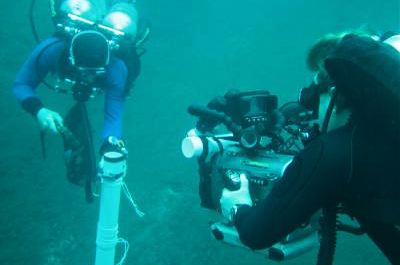 Steering clear of crocodiles and navigating around massive submerged trees, a team of divers started mapping some of the 25 freshwater pools of Cara Blanca, Belize, which were of importance to the ancient Maya civilisation.
Steering clear of crocodiles and navigating around massive submerged trees, a team of divers started mapping some of the 25 freshwater pools of Cara Blanca, Belize, which were of importance to the ancient Maya civilisation.
So far, the divers found fossilized animal remains, bits of pottery and in the largest pool explored an enormous underwater cave.
The underwater archaeology project, led by University of Illinois anthropology professor Lisa Lucero, was the first of what the professor hopes will be a series of dives into the pools of the southern Maya lowlands in central Belize.
The divers so far have explored eight of the 25 known pools of Cara Blanca, with the volunteer divers returning this summer to assess whether archaeological excavation is even possible at the bottom of the pools, some of which are more than 60 meters deep.
“We don’t know if it’s going to be feasible to conduct archaeology 200 feet below the surface,” Lucero said. “But they are going to try.”
After three weeks of surveying(see this slideshowon the University’s website), Maya structures have been found near two of the eight pools.
“The pools with the most substantial and most obvious settlement at the edge also turn out to be the deepest that we know,” Lucero said.
No vessels other than water jars were found in the structures built near the pools.
The use of these pools at the end of the Late Classic period (roughly 800-900AD) corresponds to an enduring drought that deforested parts of Central America and some believe ultimately drove the Maya from the area.
 The need for fresh water could have drawn the Maya to the pools.
The need for fresh water could have drawn the Maya to the pools.
“They could have been making offerings to the rain god and other supernatural forces to bring an end to the drought,” Lucero said.
The chemistry of the water in each of the pools is distinct and the water in Pool 1, containing the submerged cave and a Maya structure at its edge, held the freshest water of the pools surveyed.
Yet the water contained a lot of soluble minerals,problematic for anyone who used it as their primary water supply. Those who drank the water over an extended period would have been at risk of developing kidney stones,Lucero explained.
The divers also extracted core samples of the sediment at the bottoms of two of the pools. Analysis of the soil, debris and pollen in the cores isexpected to offer insight into the pool’s natural history and their surrounding region.
The Maya believed that all land was covered bywater in ancient times.An understanding possibly inspired byfossils, which served as proof that land was once covered by the sea.
‘The surface of the earth had not appeared. There was only the calm sea and the great expanse of the sky,‘ reads the Popol Vuh creation myth.
It is only when the gods ordered the water to retire, and land emerged, that the actual era began.
Thus, tothe Mayans, openings in the earth, including caves and water-filled sinkholes called cenotes from the Maya word for ‘well’represented portals to the underworld, and they often left offerings there.
Ceremonial artefacts of the Maya have been found in pools and lakes in Mexico, but not yet in Belize.